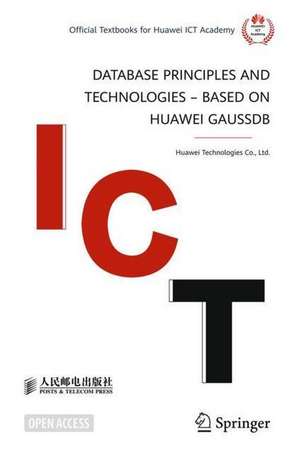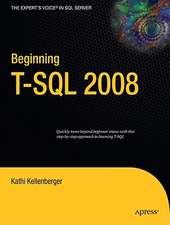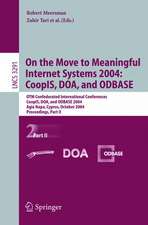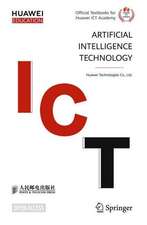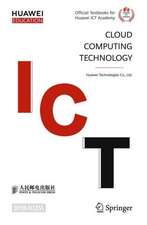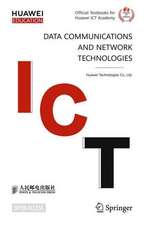Database Principles and Technologies – Based on Huawei GaussDB
Autor Huawei Technologies Co., Ltd.en Limba Engleză Paperback – 21 oct 2022
This book can be used as a textbook for database courses in colleges and universities, and is also suitable as a reference book for the HCIA-GaussDB V1.5 certification examination. The Huawei GaussDB (for MySQL) used in the book is a Huawei cloud-based high-performance, highly applicable relational database that fully supports the syntax and functionality of the open source database MySQL. All the experiments in this book can be run on this database platform.
As the world’s leading provider of ICT (information and communication technology) infrastructure and smart terminals, Huawei’s products range from digital data communication, cyber security, wireless technology, data storage, cloud computing, and smart computing to artificial intelligence.
Preț: 359.86 lei
Preț vechi: 449.82 lei
-20% Nou
Puncte Express: 540
Preț estimativ în valută:
68.89€ • 71.01$ • 58.08£
68.89€ • 71.01$ • 58.08£
Carte tipărită la comandă
Livrare economică 27 februarie-13 martie
Preluare comenzi: 021 569.72.76
Specificații
ISBN-13: 9789811930317
ISBN-10: 9811930317
Pagini: 314
Ilustrații: XIII, 314 p. 1 illus.
Dimensiuni: 155 x 235 x 21 mm
Greutate: 0.46 kg
Ediția:1st ed. 2023
Editura: Springer Nature Singapore
Colecția Springer
Locul publicării:Singapore, Singapore
ISBN-10: 9811930317
Pagini: 314
Ilustrații: XIII, 314 p. 1 illus.
Dimensiuni: 155 x 235 x 21 mm
Greutate: 0.46 kg
Ediția:1st ed. 2023
Editura: Springer Nature Singapore
Colecția Springer
Locul publicării:Singapore, Singapore
Cuprins
Chapter 1 Introduction to Database1
1.1 Overview of database technology 2
1.1.1 Data2
1.1.2 Records3
1.1.3 Databases3
1.1.4 Database management systems4
1.1.5 Database systems5
1.2 Development history of database technology5
1.2.1 The emergence and development of database technology5
1.2.2 Comparison of the three stages of data management6
1.2.5 Hierarchical model, network model and relational model8
1.2.6 Structured Query Language11
1.2.7 Characteristics of relational database12
1.2.8 History review of relational database products12
1.2.9 Other data models14
1.2.10 New challenges in data management technology15
1.2.11 NoSQL database16
1.2.12 NewSQL18
1.2.13 Database ranking19
1.3 Architecture of relational database19
1.3.1 Development of database architecture19
1.3.2 Standalone architecture20
1.3.3 Packet architecture – active/standby21
1.3.4 Packet architecture – master/slave22
1.3.5 Packet architecture – master/master22
1.3.6 Shared storage multi-site architecture23
1.3.7 Sharding architecture24
1.3.8 Non-sharing architecture24
1.3.9 Massively parallel processing architecture 25
1.3.10 Comparison of the characteristics of database architecture26
1.4 Main stream application scenarios of relational database27
1.4.1 Online transaction processing27
1.4.2 Online analytical processing27
1.4.3 Measurement indicators of database performance28
1.5 Summary of the chapter29
1.6 Exercises30
Chapter 2 Database Fundamentals31
2.1 Introduction to database management32
2.1.1 Database management and its scope of work32
2.1.2 Object management33
2.1.3 Backup and recovery management34
2.1.4 Security management38
2.1.5 Performance management41
2.1.6 Operation and maintenance management43
2.2 Important concepts of database46
2.2.1 Database and cases of database46
2.2.2 Database connection and session47
2.2.3 Schema48
2.2.4 Tablespace492.2.5 Table50
2.2.6 How tables are stored51
2.2.7 Partition52
2.2.8 Data distribution54
2.2.9 Data types55
2.2.10 View572.2.11 Index58
2.2.12 Constraints59
2.2.13 Transaction61
2.4 Exercises66
Chapter 3 Introduction to SQL Syntax...67
3.1 Overview of SQL statement68
3.1.1 Introduction to SQL statement68
3.1.2 Comprehensive application of SQL statement69
3.2 Data types69
3.2.1 Common data types70
3.2.2 Uncommon data types72
3.2.3 Cases of data types72
3.3 System functions73
3.3.1 Numeric computation functions73
3.3.2 Character handling functions75
3.3.3 Date and time functions78
3.3.4 Type conversion functions80
3.3.5 System information functions81
3.4 Operators81
3.4.1 Logical operators82
3.4.2 Comparison operators83
3.4.3 Arithmetic operators83
3.4.4 Test operators84
3.4.5 Other operators86
3.5 Summary86
3.6 Exercises86
Chapter 4 Classification of SQL Syntax…88
4.1 Data queries89
4.1.1 Simple queries89
4.1.2 Remove duplicate values90
4.1.3 Query column selection90
4.1.4 Conditional queries92
4.1.5 Join queries95
4.1.6 Subqueries99
4.1.7 Merge result set100
4.1.8 Differential result set102
4.1.9 Data packet102
4.1.10 Data sorting104
4.1.11 Data limit105
4.2 Data update105
4.2.1 Data insertion105
4.2.2 Data modification107
4.2.3 Data deletion108
4.3 Data definition110
4.3.1 Database objects110
4.3.2 Create a table110
4.3.3 Modify table properties112
4.3.4 Delete a table113
4.3.5 Index113
4.3.6 View116
4.4 Data control118
4.4.1 Transaction control118
4.4.2 Commit a transaction118
4.4.3 Rollback transaction118
4.4.4 Transaction savepoints119
4.5 Other120
4.5.1 The show command120
4.5.2 The set command121
4.6 Summary of the chapter122
4.7 Exercises122
Chapter 5 Database Security Fundamentals125
5.1 Overview of data base security features126
5.1.1 Overview of database security management126
5.1.2 Database security framework126
5.1.3 Overview of database security features126
5.2 Access control127
5.2.1 Overview of IAM127
5.2.2 IAM features127
5.2.3 IAM authorization129
5.2.4 Relationship between IAM and GaussDB (for MySQL) application129
5.2.5 Process of IAM using GaussDB (for MySQL)130
5.2.6 Detailed explanation of SSL130
5.3 User permission control131
5.3.1 Concepts of permission1315.3.2 Users132
5.3.3 Modification of users133
5.3.4 Deletion of users134
5.3.5 Roles134
5.3.6 Authorization135
5.3.7 Permission revocation137
5.4 CTS auditing138
5.4.1 Overview of CTS auditing138
5.4.2 Key operations to support the auditing139
5.5 Summary of the chapter140
5.6 Exercises140
Chapter 6 Database Development Environment141
6.1 GaussDB database drivers142
6.1.1 Introduction to the concept of drivers142
6.1.2 JDBC142
6.1.3 ODBC145
6.1.4 Others150
6.2 Database tools152
6.2.1 DDM152
6.2.2 DRS157
6.2.3 DAS162
6.3 Client tools170
6.3.1 zsql170
6.2.2 gsql178
6.2.3 Data Studio180
6.2.4 MySQL Workbench182
6.3 Summary of the chapter183
6.4 Exercises183
Chapter 7 Database Design Fundamentals185
7.1 Overview of database design186
7.1.1 Difficulties in database design186
7.1.2 Goals of database design186
7.1.3 Methods of database design187
7.2 Requirement analysis187
7.2.1 Significance of requirement analysis187
7.2.2 Tasks of requirement analysis phase188
7.2.3 Methodology of requirement analysis phase188
7.2.4 Data dictionary189
7.3 Conceptual design1897.3.1 Conceptual design and conceptual models189
7.3.2 E-R methodology190
7.4 Logical design191
7.4.1 Logical design and logical models191
7.4.2 IDEF1X method192
7.4.3 Entities and properties in the logical model192
7.4.4 Normal Form197
7.4.5 Notes for logical design203
7.5 Physical design203
7.5.1 Physical design and physical models203
7.5.2 Denormalization of physical models2047.5.3 Maintain data integrity207
7.5.4 Establish a physicalized naming convention207
7.5.5 Physicalization of tables and fields208
7.5.6 Use modelling software210
7.5.7 Outputs of physical models211
7.6 Cases of database design211
7.6.1 Scenario descriptions211
7.6.2 Regularization211
7.6.3 Data types and lengths214
7.6.4 Denormalization215
7.6.5 Index selection2167.7 Summary216
7.8 Exercises217
Chapter 8 Introduction to Huawei Database Product GaussDB219
8.1 Overview of GaussDB database220
8.1.1 GaussDB database family2208.1.2 Typical enterprise OLTP and OLAP databases221
8.2 Introduction to relational database products221
8.2.1 GaussDB (for MySQL)221
8.2.2 GaussDB (openGauss)228
8.2.3 GaussDB (DWS)230
8.2.4 Data Studio234
8.3 Introduction to NoSQL database products236
8.3.1 GaussDB (for Mongo)236
8.3.2 GaussDB (for Cassandra)238
8.4 Summary of the chapter239
8.5 Exercises239Notă biografică
Huawei Technologies Co., Ltd. Founded in 1987, Huawei is a leading global provider of information and communications technology (ICT) infrastructure and smart devices. We have approximately 197,000 employees and we operate in over 170 countries and regions, serving more than three billion people around the world.
Huawei’s mission is to bring digital to every person, home and organization for a fully connected, intelligent world. To this end, we will: drive ubiquitous connectivity and promote equal access to networks to lay the foundation for the intelligent world; provide the ultimate computing power to deliver ubiquitous cloud and intelligence; build powerful digital platforms to help all industries and organizations become more agile, efficient, and dynamic; redefine user experience with AI, offering consumers more personalized and intelligent experiences across all scenarios, including home, travel, office, entertainment, and fitness & health.
Huawei’s mission is to bring digital to every person, home and organization for a fully connected, intelligent world. To this end, we will: drive ubiquitous connectivity and promote equal access to networks to lay the foundation for the intelligent world; provide the ultimate computing power to deliver ubiquitous cloud and intelligence; build powerful digital platforms to help all industries and organizations become more agile, efficient, and dynamic; redefine user experience with AI, offering consumers more personalized and intelligent experiences across all scenarios, including home, travel, office, entertainment, and fitness & health.
Textul de pe ultima copertă
This open access book contains eight chapters that deal with database technologies, including the development history of database, database fundamentals, introduction to SQL syntax, classification of SQL syntax, database security fundamentals, database development environment, database design fundamentals, and the application of Huawei’s cloud database product GaussDB database.
This book can be used as a textbook for database courses in colleges and universities, and is also suitable as a reference book for the HCIA-GaussDB V1.5 certification examination. The Huawei GaussDB (for MySQL) used in the book is a Huawei cloud-based high-performance, highly applicable relational database that fully supports the syntax and functionality of the open source database MySQL. All the experiments in this book can be run on this database platform.
As the world’s leading provider of ICT (information and communication technology) infrastructure and smart terminals, Huawei’s products range from digital data communication, cyber security, wireless technology, data storage, cloud computing, and smart computing to artificial intelligence.
This book can be used as a textbook for database courses in colleges and universities, and is also suitable as a reference book for the HCIA-GaussDB V1.5 certification examination. The Huawei GaussDB (for MySQL) used in the book is a Huawei cloud-based high-performance, highly applicable relational database that fully supports the syntax and functionality of the open source database MySQL. All the experiments in this book can be run on this database platform.
As the world’s leading provider of ICT (information and communication technology) infrastructure and smart terminals, Huawei’s products range from digital data communication, cyber security, wireless technology, data storage, cloud computing, and smart computing to artificial intelligence.
Caracteristici
Designated by Huawei HiAI certi
Covers database fundamentals, database design techniques, database security and applications on Huawei GaussDB
Adopts the new Huawei GaussDB cloud database platform, easy to learn in a practical environment
Covers database fundamentals, database design techniques, database security and applications on Huawei GaussDB
Adopts the new Huawei GaussDB cloud database platform, easy to learn in a practical environment
